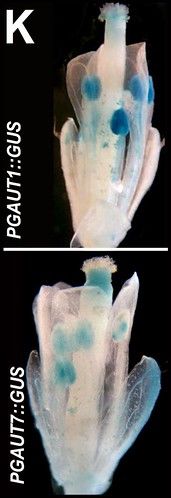This post is part of the Science Tuesday feature series on the USDA blog. Check back each week as we showcase stories and news from the USDA's rich science and research portfolio.
One of the keys to improving biofuel production is to understand how plants are made and function. Two researchers from the University of Georgia (UGA) have made strides in understanding how plant cell walls are made, opening a new door to converting plants to biofuels and other carbon-based products.
UGA researcher Debra Mohnen and her team discovered that two proteins (GAUT1 and GAUT7) come together in an unexpected way to make a carbohydrate, or a chain of sugar molecules, in plant cell walls. The work was funded through USDA’s National Institute of Food and Agriculture.
This finding builds upon Mohnen’s previous research that discovered GAUT1 as the first protein shown to synthesize pectin, which is a major component of the plant cell wall. Together with GAUT7, which doesn’t have a pectin-synthesizing activity, they form a critical part of a pectin-synthesizing protein complex.
Additionally, this two-protein complex may serve as a core complex that associates with additional proteins that can synthesize pectin – forming still larger carbohydrate-synthesizing complexes in plant cells. This discovery could be a critical step in changing our view of how plant cell walls are made.
Pectins are synthesized in all plant cell wall types, including wood and grasses (used in the production of bioenergy) that have tough and different outer walls. It is most commonly believed to be involved in the synthesis of the thinner, primary cell wall, but this research found it plays a role in the synthesis of the tougher secondary cell wall that gives the plant rigidity. This discovery makes it likely that modification of pectin will improve the availability of carbon reserves in the plant cell wall for renewable sources of energy.
This discovery gives researchers a key to understanding plant development, which could lead to improvements in the methods used to break down carbohydrate structures into the fermentable sugars used to produce biofuels.

